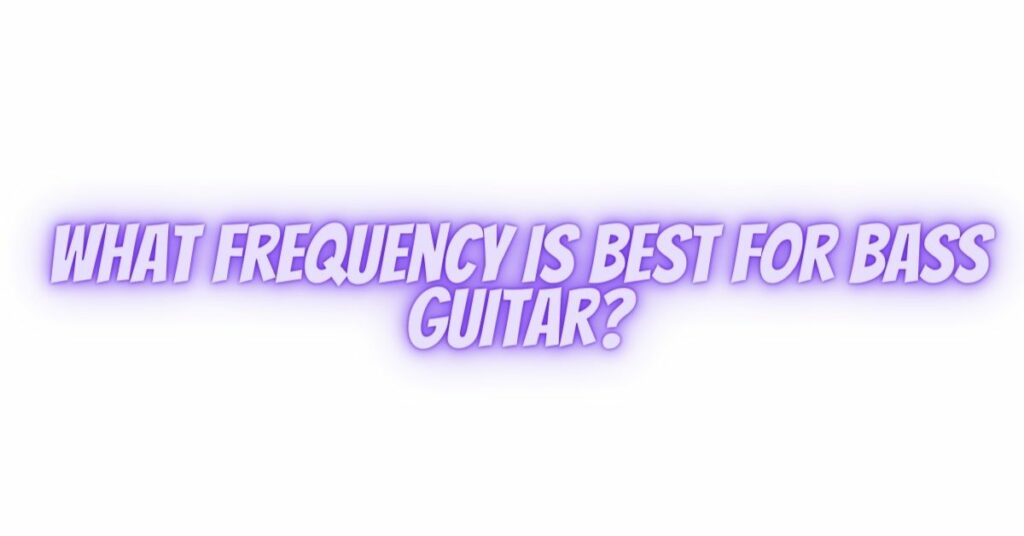The bass guitar is the rhythmic foundation of many music genres, providing the deep, resonant notes that give a song its groove and power. To achieve the best sound and ensure it fits harmoniously within a mix, understanding and controlling the bass guitar’s frequency range is crucial. In this comprehensive article, we’ll explore the optimal frequencies for bass guitar and how to make the most of this instrument in various musical contexts.
The Basics of Bass Guitar Frequencies
Bass guitar frequencies encompass the range of pitches that the instrument can produce. The fundamental frequency of a note played on a bass guitar is determined by the length, thickness, and tension of the strings. The typical four-string bass guitar is tuned to E-A-D-G, with the lowest-pitched string being the E string, and the highest-pitched string being the G string.
Here are the approximate frequencies associated with each string on a standard four-string bass guitar:
- Low E (thickest string): About 41.2 Hz
- A: Approximately 55 Hz
- D: Roughly 73.4 Hz
- G (thinnest string): Around 98 Hz
In addition to the fundamental frequencies, the bass guitar produces harmonics and overtones that contribute to its overall tonal character. These harmonics are multiples of the fundamental frequency and are crucial for creating the distinctive timbre of the instrument.
Finding the Sweet Spot: The Optimal Frequency Range
The optimal frequency range for a bass guitar primarily depends on the style of music you’re playing and your specific role within the ensemble. Here are some general guidelines for finding the sweet spot:
- Low-End Foundation (40-120 Hz): The fundamental frequencies of the bass guitar typically fall within the range of 40 to 120 Hz. This low-end range is where the instrument provides the foundational groove and power in most music genres. For rock, pop, funk, and blues, this is the heart of the bass guitar’s role.
- Upper Harmonics (120-400 Hz): Above the fundamental frequencies, you’ll find the upper harmonics and overtones, which give the bass its tone and articulation. This range, approximately 120 to 400 Hz, allows the bass to cut through the mix and be heard distinctly.
- Midrange (400-1,000 Hz): In some genres, like slap bass in funk or progressive rock, you might want to emphasize the midrange frequencies. These frequencies, from 400 to 1,000 Hz, bring out the snap and attack in your basslines.
- High-End Clarity (1,000 Hz and up): While bass guitars aren’t typically associated with high frequencies, some styles may benefit from a touch of high-end clarity. This can help the bass guitar be more articulate and present in the mix.
Tailoring Your Sound to the Genre
The ideal bass guitar frequency range can vary widely depending on the music style you’re playing. Here’s how the optimal frequencies can be adjusted for different genres:
- Rock and Pop: In rock and pop music, the low-end frequencies around 40-80 Hz provide the essential groove, while the upper harmonics between 120-400 Hz add clarity and articulation to the basslines.
- Funk and Slap Bass: Funk music often highlights the midrange frequencies (400-1,000 Hz) to accentuate the percussive and slap-style playing. It brings out the sharpness of the bass sound.
- Jazz and Jazz Fusion: Jazz basslines often lean on the midrange and upper frequencies (400-1,000 Hz) to provide a clear and warm tone, allowing the bass to complement the other instruments in a subtle way.
- Metal and Heavy Rock: In heavy music genres, the low-end frequencies (40-80 Hz) are intensified to create a massive, powerful sound. This helps the bass guitar blend with the heavy guitars and pounding drums.
Tone Shaping and Equalization
Achieving the best bass guitar sound often involves using equalization (EQ) to shape the frequency response to match the music’s requirements. Here are some tips for effective tone shaping:
- Low-Cut Filter: Apply a low-cut filter to remove unwanted subsonic frequencies (below 20-30 Hz), which can cause muddiness in the mix.
- Boosting Key Frequencies: Use a parametric EQ to boost the frequencies that define your bass sound. For example, add a gentle boost around 80-100 Hz for warmth and punch.
- Cutting Muddiness: To reduce muddiness, consider cutting frequencies around 200-400 Hz, depending on your bass and mix.
- Highlighting Clarity: Boosting frequencies between 1,000-2,000 Hz can bring out articulation and definition in your basslines.
- High-End Clarity: If you want more high-end presence, apply a gentle boost above 2,000 Hz. Be cautious not to overdo it, as excessive high frequencies can lead to a harsh tone.
Conclusion
Understanding the optimal bass guitar frequencies is crucial for any bassist looking to achieve the best sound in various musical contexts. The key to success is tailoring your sound to the genre, using EQ effectively, and adjusting your playing technique to suit the specific role of the bass in the band. Whether you’re delivering a groovy bassline in a rock band or slapping out funky rhythms in a funk ensemble, a deep understanding of bass guitar frequencies is the path to sonic excellence and a powerful groove.


